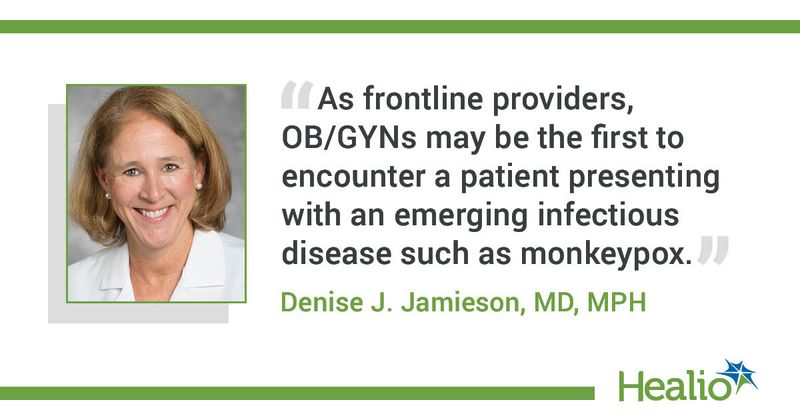Q&A: Monkeypox considerations for OB/GYNs
In a commentary published in Obstetrics & Gynecology, experts from the CDC and Emory University in Atlanta, Georgia, discussed the clinical implications of the current monkeypox outbreak.
By July 5, the viral infection had been reported in 52 nonendemic countries, as well as 26 states and Washington, D.C., and primarily affected men who have sex with men, according to the commentary.

However, seven cases of monkeypox had occurred in women and transgender men as of that date. As such, it is important to acknowledge that OB/GYNs may be the first point of contact for this demographic of patients.
Healio spoke with Denise J. Jamieson, MD, MPH, James Robert McCord Professor and chair of the department of gynecology and obstetrics at Emory University, to learn more about monkeypox in the context of OB/GYN practice.
Healio: Why is it important for OB/GYNs to know about monkeypox?
Jamieson: Although there is very limited information about monkeypox infection during pregnancy (five reported cases in literature), based on what we know about other orthopoxviruses such as smallpox, there may be an increased risk for severe disease. Smallpox, a closely related virus, is more severe during pregnancy and is associated with an increased fatality rate during pregnancy. Adverse pregnancy outcomes such as miscarriage, stillbirth and preterm birth may also be higher in pregnant people with monkeypox. Monkeypox, like other orthopoxviruses, can be transmitted from mother to fetus.
Healio: What should OB/GYNs be looking for? How vigilant should they be?
Jamieson: OB/GYNs should take a careful travel history and assess potential contact with monkeypox. Patients presenting with an unexplained fever, rash or significant lymphadenopathy should be isolated from others and placed in a separate room. OB/GYNs encountering a patient with suspected monkeypox should consult with their hospital infection control specialists and/or public health authorities. Samples should be collected from two or three areas of the body and sent for testing. Although diagnosis of monkeypox is a two-step process (preliminary identification of an orthopoxvirus followed by monkeypox-specific viral testing), OB/GYNs should not wait for confirmatory testing to initiate treatment and prevention measures.
Healio: How should OB/GYNs address monkeypox?
Jamieson: Since the vast majority of OB/GYNs have never seen a case of monkeypox, it is important that they are knowledgeable about the signs and symptoms and that they understand who to test and treat. Those patients exposed to monkeypox may be eligible for postexposure prophylaxis with the Jynneos vaccine, ideally within 4 days of exposure, but it may be given up until 14 days after exposure. Pregnant patients diagnosed with severe monkeypox may be eligible to receive antiviral therapy or immune globulin.
Healio: How does the current spread of monkeypox affect OB/GYN practice?
Jamieson: As frontline providers, OB/GYNs may be the first to encounter a patient presenting with an emerging infectious disease such as monkeypox. In addition, patients with genital lesions associated with monkeypox may present to their OB/GYN for evaluation of a sexually transmitted infection.
Healio: Where can more OB/GYN-specific information on monkeypox be found?
Jamieson: The CDC has a website that includes updated information on the number and distribution of cases nationally and globally, as well as testing, treatment and prevention guidance.
Healio: Is there anything else that is important for OB/GYNs to know about monkeypox?
Jamieson: First, there has been a call by scientists to rename the virus and its clades to reduce stigma. WHO is working to do this. Secondly, monkeypox is yet another example of an emerging pathogen that may affect a pregnant person. OB/GYNs should pay attention to new outbreaks of infectious diseases and be prepared to respond within their practice.
References:
- Meaney-Delman DM, et al. Obstet Gynecol. 2022;doi:10.1097/AOG.0000000000004909.
- Monkeypox. https://www.cdc.gov/poxvirus/monkeypox/index.html. Published June 30, 2022. Accessed July 22, 2022.
